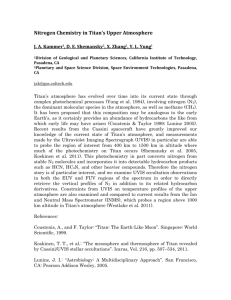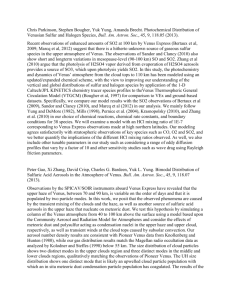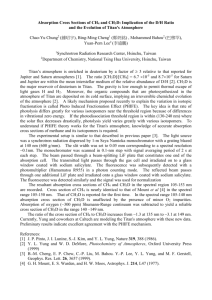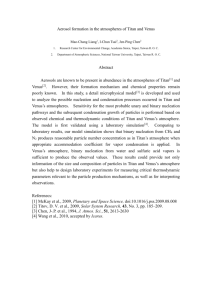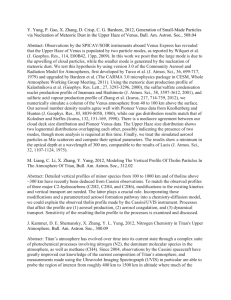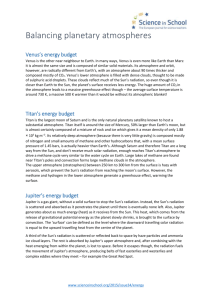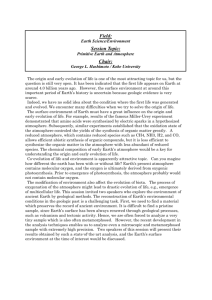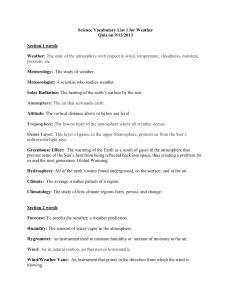DPS_2010_abstract
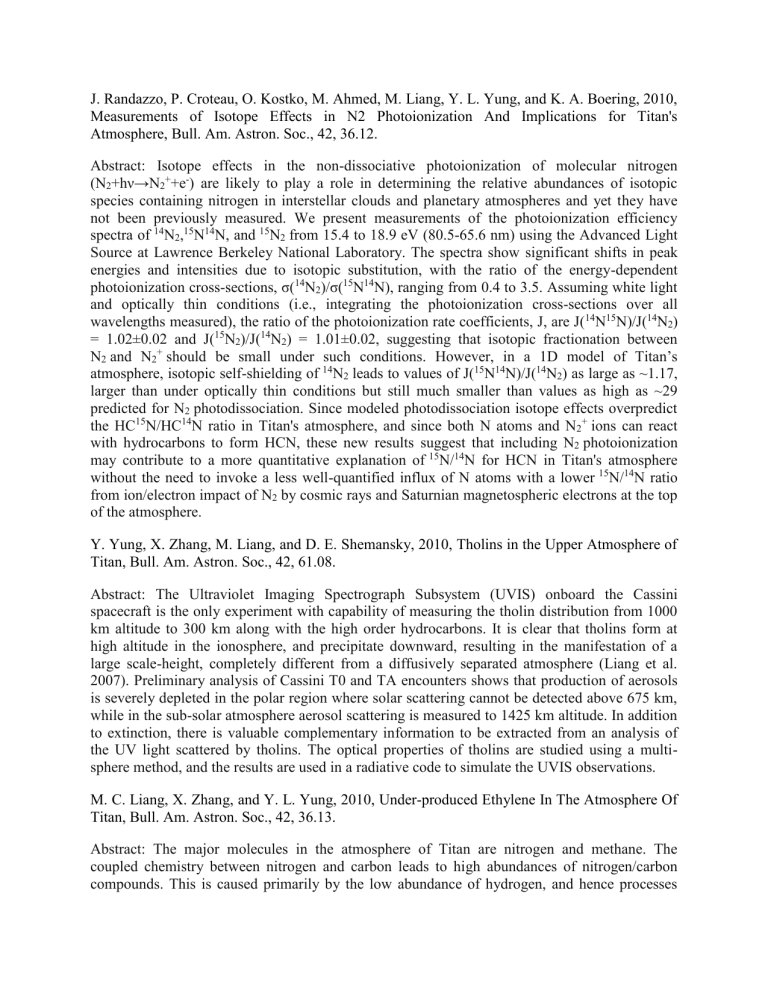
J. Randazzo, P. Croteau, O. Kostko, M. Ahmed, M. Liang, Y. L. Yung, and K. A. Boering, 2010,
Measurements of Isotope Effects in N2 Photoionization And Implications for Titan's
Atmosphere, Bull. Am. Astron. Soc., 42, 36.12.
Abstract: Isotope effects in the non-dissociative photoionization of molecular nitrogen
(N
2
+hν→N
2
+
+e
-
) are likely to play a role in determining the relative abundances of isotopic species containing nitrogen in interstellar clouds and planetary atmospheres and yet they have not been previously measured. We present measurements of the photoionization efficiency spectra of
14
N
2
,
15
N
14
N, and
15
N
2
from 15.4 to 18.9 eV (80.5-65.6 nm) using the Advanced Light
Source at Lawrence Berkeley National Laboratory. The spectra show significant shifts in peak energies and intensities due to isotopic substitution, with the ratio of the energy-dependent photoionization cross-sections, σ(
14
N
2
)/σ( 15
N
14
N), ranging from 0.4 to 3.5. Assuming white light and optically thin conditions (i.e., integrating the photoionization cross-sections over all wavelengths measured), the ratio of the photoionization rate coefficients, J, are J(
= 1.02±0.02 and J( 15
N
2
)/J(
14
14 N 15 N)/J( 14 N
2
)
N
2
) = 1.01±0.02, suggesting that isotopic fractionation between
N
2
and N
2
+
should be small under such conditions. However, in a 1D model of Titan’s atmosphere, isotopic self-shielding of 14 N
2
leads to values of J( 15 N 14 N)/J( 14 N
2
) as large as ~1.17, larger than under optically thin conditions but still much smaller than values as high as ~29 predicted for N
2
photodissociation. Since modeled photodissociation isotope effects overpredict the HC
15
N/HC
14
N ratio in Titan's atmosphere, and since both N atoms and N
2
+
ions can react with hydrocarbons to form HCN, these new results suggest that including N
2
photoionization may contribute to a more quantitative explanation of
15
N/
14
N for HCN in Titan's atmosphere without the need to invoke a less well-quantified influx of N atoms with a lower
15
N/
14
N ratio from ion/electron impact of N
2
by cosmic rays and Saturnian magnetospheric electrons at the top of the atmosphere.
Y. Yung, X. Zhang, M. Liang, and D. E. Shemansky, 2010, Tholins in the Upper Atmosphere of
Titan, Bull. Am. Astron. Soc., 42, 61.08.
Abstract: The Ultraviolet Imaging Spectrograph Subsystem (UVIS) onboard the Cassini spacecraft is the only experiment with capability of measuring the tholin distribution from 1000 km altitude to 300 km along with the high order hydrocarbons. It is clear that tholins form at high altitude in the ionosphere, and precipitate downward, resulting in the manifestation of a large scale-height, completely different from a diffusively separated atmosphere (Liang et al.
2007). Preliminary analysis of Cassini T0 and TA encounters shows that production of aerosols is severely depleted in the polar region where solar scattering cannot be detected above 675 km, while in the sub-solar atmosphere aerosol scattering is measured to 1425 km altitude. In addition to extinction, there is valuable complementary information to be extracted from an analysis of the UV light scattered by tholins. The optical properties of tholins are studied using a multisphere method, and the results are used in a radiative code to simulate the UVIS observations.
M. C. Liang, X. Zhang, and Y. L. Yung, 2010, Under-produced Ethylene In The Atmosphere Of
Titan, Bull. Am. Astron. Soc., 42, 36.13.
Abstract: The major molecules in the atmosphere of Titan are nitrogen and methane. The coupled chemistry between nitrogen and carbon leads to high abundances of nitrogen/carbon compounds. This is caused primarily by the low abundance of hydrogen, and hence processes
that “recycle” photolytic products of methane back to methane become inefficient. Though the current hydrocarbon/nitrogen kinetics schemes have been accepted for years, there remain major uncertainties. Even ethylene, one of simplest hydrocarbons, the abundance in the stratosphere of
Titan is under-estimated by most updated photochemical models, by as much as an order of magnitude. A recent laboratory measurement carried out by Adamkovics and Boering (2003) provides an important constraint to test the hydrocarbon kinetics. One most important constraint is that the time-dependency of the abundances of hydrocarbons is observed. To fully test the sensitivity of chemical reactions to the abundances of the produced products and also to resolve the issue of under-predicted ethylene, an adjoint model is developed in complementary to the existing forward Caltech/JPL KINETICS model. We find that the abundances of C2H2, C2H4,
C2H6, and C4H10 can now be well reproduced while that of C4H2 is underestimated by 1-2 orders of magnitude. The abundance of C3H4 is underestimated with Moses et al.’ (2000) kinetics but overestimated with Moses et al.’ (2005) kinetics. This suggests a major gap in our understanding of chemical pathways to higher hydrocarbons.
D. E. Shemansky, Y. Yung, X. Zhang, X. Liu, and J. Kammer, 2010, Vertical Structure Of The
Titan Atmosphere From Cassini UVIS Observations, Bull. Am. Astron. Soc., 42, 36.08.
Abstract: The reduction and model analysis of Titan vertical atmospheric structure obtained from
EUV/FUV stellar and solar occultations from Cassini UVIS experiment will be presented.
Related atmospheric emission properties will also be described. The observations show both latitude and longitude dependencies in vertical structure of the hydrocarbon species. Dayside depletion of CH4 and higher order hydrocarbons is observed at altitudes above 880 km, allowing the establishment of limits on diffusion and production rates. Hydrocarbon mixing ratios show latitudinal dependencies of as much as a factor of 4. Higher order hydrocarbons including extinction by aerosols show scale heights larger than CH4 below the exobase, indicating that these species are showing the impact of forcing by chemical production and downward diffusion.
The higher order hydrocarbons show density peaks in the 500 -- 700 km region. Aerosol mixing ratios decrease with decreasing altitude as do the higher order hydrocarbons down to ~450 km where the distribution makes a sudden transition to constancy with the major species. The aerosols, as the end point of hydrocarbon physical chemistry, constitute the key component determining the state of the atmosphere.
X. Zhang, R. A. West, D. Banfield, Y. L. Yung, 2010, Aerosol Heating in the Stratosphere of
Jupiter, Bull. Am. Astron. Soc., 42, 11.11
Abstract: This work is composed of two parts. First, latitudinal and vertical distributions of
Jovian stratospheric aerosols are retrieved based on the Cassini ISS (Imaging Science
Subsystem) images in the strong methane absorption band at 890 nm and previous work by
Banfield et al. (Icarus, 134, 11, 1998). Second, heating rates due to stratospheric aerosol layers are calculated by a multiple scattering model in the visible wavelengths. Our model used the methane k-distribution parameters from Karkoschka and Tomasko (Icarus, 205, 674, 2010) and
H2-H2 continuum absorption coefficients from Borysow et al. (A&A, 390, 779, 2002). Two types of aerosol are distinguished. Haze at low and middle latitude is optically thin and can be treated as Mie particles. And the high latitude aerosols with large optical depth are modeled as aggregated particles using the multi-sphere method (Mackowski and Mishchenko, J. Opt. Soc.
Amer. A., 13, 2266, 1996). The effect of the aerosol heating rates on the radiative balance of stratosphere of Jupiter is studied.
C. D. Parkinson, F. Mills, A. Brecht, S. W. Bougher, Y. L. Yung, 2010, Photochemical
Distribution of Venusian Sulfur and Halogen Species, Bull. Am. Astron. Soc., 42, 10.04
Abstract: The photochemistry of Venus’ atmosphere from the cloudtops to 110 km has been modeled using an updated/expanded chemical scheme, with the view to improving our understanding of the vertical distributions of sulfur and halogen species. We mainly follow Yung and DeMore (1982), Mills (1998), Pernice et al. (2004), and Krasnopolsky (2009) in our choice of chemical reactions, chemical rate constants, and boundary conditions for several key species.
We examine two models, with HCl mixing ratios of 10-7 and 4 x 10-7, respectively. The former corresponds to Venus Express observations made at high northern latitudes and the latter to the mid- to low-latitude value Young (1972) determined based on infrared measurements by Connes et al (1967). Both models agree satisfactorily with stratospheric observations of key species such as CO, O2 and SO2, but we hope to better quantify the implications of the different HCl mixing ratios observed. Additionally, we perform sensitivity tests where water is set to ~31 ppm at 40 km, but vary the SO2 mixing ratio at the lower boundary about a nominal value of ~25 ppm. We also consider a range of eddy diffusion profiles and other sensitivity studies. For most cases, K =
Ko (n(z)/n_ref)-a, where Ko is the eddy diffusion coefficient at some reference altitude, n is the number density, z is altitude, and a is the variable parameter (<1). Our modeling suggests lower
HCl abundances result in greater abundances of SO2, SO, and SO3 generally lower O2 abundances, and greater ClO abundances. Also, the effects on sulfur compounds seems more evident/pronounced for lower mixing ratios of SO2 at the lower boundary as well as higher up in the atmosphere i.e. above ~58 km. We consider both SO2 observations of Bertaux et al (2009) and Sandor and Clancy (2010) in our analysis of results.
M. R. Line, P. Chen, Y. L. Yung, 2010, The Impact of UV Irradiance on the Composition of
Exoplanets, Bull. Am. Astron. Soc., 42, 52.03
Abstract: A majority of extrasolar giant planets are within a few hundredths of an AU from their parent star. Their proximity subjects them to high amounts of UV flux compared to what bodies in our own solar system receive. Therefore, we expect photochemistry to play a significant role in the composition of their visible atmospheres. Here we will present photochemical results that demonstrate the effects of different UV fields for F, G, K and M stars using HD189733b and
GJ436b as examples. Effects of different eddy mixing strengths and metallicty will also be investigated as they determine where the boundary between thermochemistry and transport occurs and thus determine the bulk composition of the visible atmosphere.
